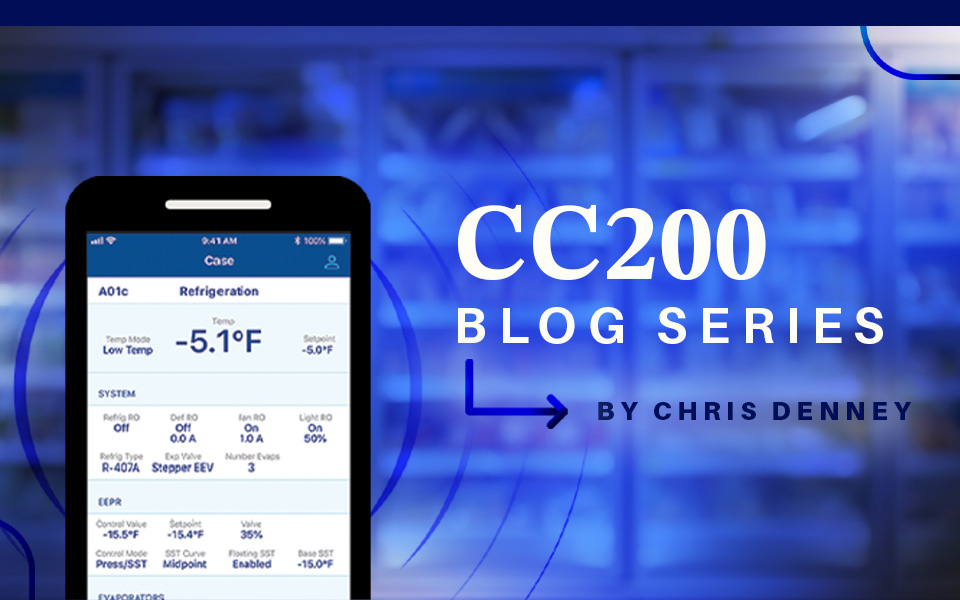*On June 1, 2023 Emerson’s Climate Technologies business became a new standalone company – Copeland. Though our name has changed, we are building on more than a century of HVACR innovation and industry leadership, and Copeland continues to offer the same products, industry stewardship, and learning opportunities you’ve grown to trust. Information found on this webpage posted before June 1, 2023 may contain our old name or branding, but you can be at ease knowing it was created with the knowledge and expertise of Copeland.
Electronic controls have become essential components in modern commercial refrigeration equipment. Driven by the needs to simplify maintenance, increase performance and reliability, transition to lower-GWP refrigerants, and optimize energy efficiency, system and case controls are enabling a new era of refrigeration management — for end users and service technicians alike.
Copeland recently launched the CC200 case controller, a robust case-level control platform and key piece of its integrated system control strategy. To explore its many features and benefits, Sean Gay, Copeland’s lead field service specialist, and I completed work on an educational video series and companion blog posts. In this first of three blogs, I’ll introduce the main benefits, hardware and components of the CC200 solution.

Key benefits, hardware components and solution overview
The CC200 is designed to maximize the performance and efficiency of refrigerated cases or walk-in units leveraging the next generation of lower-GWP refrigerants. It controls air temperature, defrost, superheat and evaporator pressure in low-, medium- and dual-temperature systems with up to three evaporators. By continually monitoring suction pressure, case temperature and superheat, the CC200 maintains optimum system efficiencies and setpoints.
The full CC200 solution is comprised of four main components: a main controller; one to three expansion modules; a display; and Bluetooth® connectivity to the Cold Chain Connect mobile app. To help simplify servicing and quickly diagnose issues, you’ll find pluggable connectors and color-coded temperature and pressure inputs on the main controller — which match the colors of their respective wire inputs.
Up to three expansion modules can be added to the CC200 (i.e., one for each evaporator), which easily snap onto the CC200’s main controller to tap into its power source and communication capabilities.
By connecting to the Cold Chain Connect mobile app, technicians and end users can perform a variety of tasks without having to access the case itself. Free for use on Apple and Android devices, Cold Chain Connect provides visibility to a wealth of evaporator and CC200 controller information. Technicians can quickly see air temperature, pressure, superheat and controller status — and perform key service actions such as manual defrost or overriding valves and relays.
The CC200’s touch-screen display allows technicians to simply swipe, touch and hold the Bluetooth icon to connect with Cold Chain Connect. It includes essential status icons that enable technicians or end users to quickly check fan, defrost, refrigeration and lighting status. From the display, technicians can also perform key case functions such as manual defrost, service shutdown and controller reboot.
Combined, the CC200 and Cold Chain Connect app deliver more than 40 data points to help with performance testing, servicing and troubleshooting.
Mounting and installing an expansion module
To control more evaporators or an EEPR valve, CC200 expansion modules can be added to the CC200 main controller. Expansion modules can be mounted in one of two ways:
- Attach to the case or remote panel by fastening a machine screw through the mounting tabs.
- Mount on a DIN rail next to the main CC200 controller, and then slide the expansion module and CC200 expansion port connectors together.
Only one power source is needed at the main controller when attaching an expansion module via the expansion port connectors. — with no wiring needed between devices. Additional expansion modules (up to three total) can be installed simply by sliding expansion port connectors together.
These flexible mounting options make the CC200 and its expansion modules easily adaptable to nearly any case type.
To learn more about the CC200 case controller, please view our complete video series. Our next blog will explain how the CC200 is designed to support CO2 applications.

8 proven strategies for rigorous cold chain management
Preparing for the approval and safe use of A2Ls in commercial refrigeration applications...
Protection for high-value shipments just got even better
We’re excited to announce the release of Copeland’s newest real-time tracker, the GO Real-Time...

Three proven strategies to prevent cargo theft
The over-the-road (OTR) transport industry is experiencing a surge in cargo thefts. As thieves...
